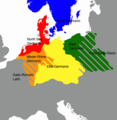File:Germanic dialects ca. AD 1.png
Appearance

Tamaño di bista previo: 536 × 600 pixels. Otro resolushon: 215 × 240 pixels | 429 × 480 pixels | 687 × 768 pixels | 915 × 1,024 pixels | 2,067 × 2,312 pixels.
Fail original (2,067 × 2,312 pixel, tamaño di fail: 703 KB, MIME type: image/png)
Historia di fail
Klek riba un fecha/ora pa mira e fail, manera e tabata na e momentu ei.
| Fecha/Ora | Miniatura | Dimenshonnan | Usuario | Komentario | |
|---|---|---|---|---|---|
| aktual | 10:28, 30 mei 2024 |  | 2,067 × 2,312 (703 KB) | Vlaemink | According to Seebold et al. the Rhine Weser dialects were spoken further east during the 1st century CE. The previous version seems to show a situation closer to the 3rd and 4th century. |
| 15:20, 14 aprel 2022 |  | 2,067 × 2,312 (776 KB) | Mårtensås | Reverted to version as of 11:11, 11 January 2022 (UTC) | |
| 15:18, 14 aprel 2022 |  | 2,067 × 2,312 (767 KB) | Mårtensås | Minor olor fix | |
| 11:11, 11 yanüari 2022 |  | 2,067 × 2,312 (776 KB) | Vlaemink | This map seems to show a situation closer to 400-600 CE than 1CE, according to Seebold (Seebold, Elmar (2003): Die Herkunft der Franken, Friesen und Sachsen) the Northsea Germanic territories at this point in time did not yet include the Northern Netherlands. | |
| 15:43, 15 òktober 2018 |  | 2,067 × 2,312 (791 KB) | Ax quinque | Reverted to version as of 09:48, 4 May 2018 (UTC) Reverted to more detailed version of the map by AKAKIOS. | |
| 11:30, 22 ougùstùs 2018 |  | 419 × 431 (15 KB) | Shmurak | Reverted to stable version | |
| 09:48, 4 mei 2018 |  | 2,067 × 2,312 (791 KB) | E-960 | Reverted to version as of 20:02, 5 December 2017 (UTC) The other map's boundaries look suspiciously like the boundaries of the Greater Third Reich (see talk page) | |
| 11:12, 30 mart 2018 |  | 419 × 431 (36 KB) | Til Eulenspiegel | Reverted to version as of 17:44, 5 December 2017 (UTC) used on 3 pages in am., we never wanted a new version, just make a new file instead of overwrite this one we use | |
| 20:02, 5 desèmber 2017 |  | 2,067 × 2,312 (791 KB) | AKAKIOS | Reverted to version as of 20:06, 3 December 2017 (UTC) Assuming good faith, while waiting on sources for claims. | |
| 19:58, 5 desèmber 2017 |  | 2,067 × 2,312 (816 KB) | AKAKIOS | Reverted to version as of 07:50, 4 December 2017 (UTC) |
Uso di fail
E próksimo 2 pages use ta uza e fail akí:
Uso global di fail
E próksimo otro wikinan ta usa e fail akí
- Uso na af.wikipedia.org
- Uso na am.wikipedia.org
- Uso na an.wikipedia.org
- Uso na ar.wikipedia.org
- Uso na be-tarask.wikipedia.org
- Uso na bg.wikipedia.org
- Uso na cs.wikipedia.org
- Uso na de.wikipedia.org
- Uso na el.wikipedia.org
- Uso na en.wikipedia.org
- Suebi
- Proto-Germanic language
- Talk:Low Franconian
- East Germanic languages
- Ingaevones
- Istvaeones
- North Sea Germanic
- List of Indo-European languages
- Frankish language
- List of early Germanic peoples
- Talk:List of early Germanic peoples
- Elbe Germanic
- Weser–Rhine Germanic
- Dutch language
- User:Kazkaskazkasako/Books/All
- Ingvaeonic nasal spirant law
- North Germanic peoples
- Glossary of sound laws in the Indo-European languages
- Elbe Germanic peoples
- User:AKAKIOS/sandbox
- User:Falcaorib/Ancient Empires (01 AD-150 AD)
- User:Falcaorib/Germany and Prussia
- User:Falcaorib/Iran
- User:Atavoidirc/I.E. languages
- Uso na es.wikipedia.org
- Uso na fa.wikipedia.org
- Uso na fi.wikipedia.org
- Uso na fr.wikipedia.org
- Uso na fy.wikipedia.org
- Uso na gl.wikipedia.org
Mira mas uzo global di e fail akí.

